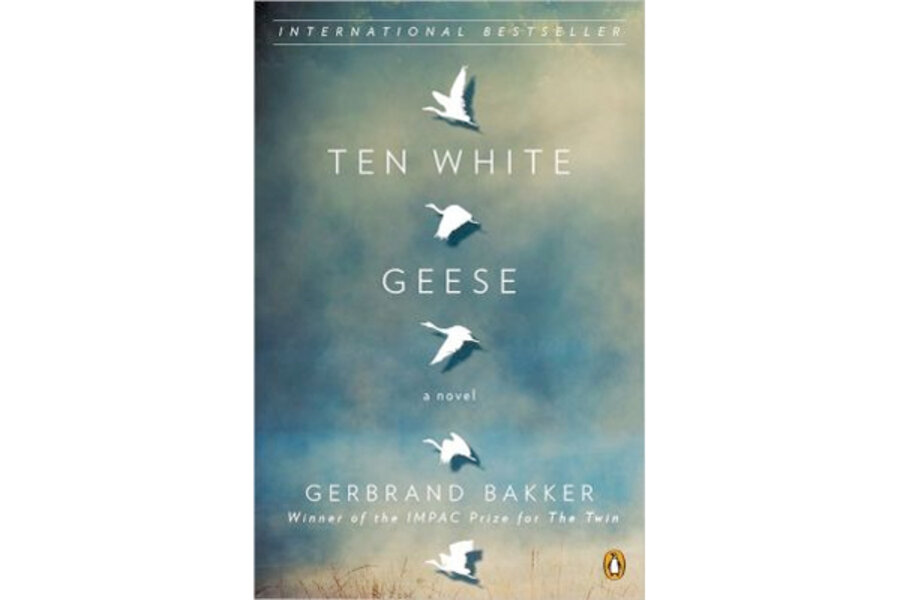Ten White Geese
Loading...
In this spare yet sensual novel of landscape and meditation, a Dutch Emily Dickinson scholar with a mysterious ailment escapes an unhappy marriage and arrives in Wales to live in a rural farmhouse. The book hints at her history in a few broad strokes. The land she’s arrived to spend time in is spare and punctuated with odd garden paths, kissing gates that are overgrown with vines, and, nearby, a yard full of geese, none of which seem to belong to anyone. This I’m-nobody-who-are-you quality rather fits the Dickinson scholar, who spends so much time alone in the first part of the book that we have no reason to learn her name. Rather we learn how she sees landscape through her window and how she comes to plot bodily landmarks around her – the movement of paths to and from the bakery, the nearby pool with its warm stones and tempting water, the looming Welsh mountain that always seems to have its head in a cloud.
Beware: if you’re not in the mood for this kind of slow contemplation, if you’re craving events and dialog, this book may not be for you. Indeed, for a great many pages, this Dickinsonian’s communion is mainly with geese, who keep mysteriously disappearing from the pen, and with a badger, who, improbably, bites her. She’s left her cell phone behind on the boat to Wales. Reading this book may make you feel fantastically solitary, too.
Yet what is the point of this kind of hermitage? Even when visitors come, the answers are not wholly revealed. We learn something about the marriage the woman left behind and something about some foiled hopes and stifled passions. We infer the progression of an illness. But mostly, we learn to see the landscape the way the scholar does, watch it change as she changes.
Gerbrand Bakker is at once a prizewinning fiction writer (for "The Twin") and a person who makes his living as a gardener, and it's the gardener's solitary physicality that makes this book luminous. As she settles into her lonely cottage, the Dutch woman devotes as much energy as she has left to clipping vines and laying stones, to working in the sun just for the sake of work in the sun. Perhaps as a result, the thinking and feeling in this book have something remarkably organic about them. Bakker’s language is studded with sensuality, in sentences that seem to rise out of the laboring body. Indeed, what I admired most about this book, was its keen attentions to the movements of cows; the way that it tracked the movements of the physical day giving rise to work; the way that – when we are lucky enough to feel alone – the things of the world seem to express the movements of mind.
In one such lovely passage
She had seen time passing in the rotation of the long shadows of the trees, the arrival of a school of fish at her toes and their departure, and the appearance of five sheet next to the standing stone. Was this it, what Emily Dickinson had done for almost her entire adult life? Had she tried to hold back time, making it bearable and less lonely to perhaps, by capturing it in hundreds of poems?
It’s fine prose. Nevertheless, as something of a Dickinson lover myself, I found this book’s use of Dickinson rather flimsy -– a plot-front for a way of thinking about being alone, with warmth and deep insight and believable scholarship somewhat lacking. Dickinson certainly pondered the mysteries of landscape and death (often in linked ways) but her poems were also joyful, colorful, and even chatty. Her strangeness is so full of metaphysical life that it becomes disarmingly conversational. ("Bee! I'm expecting you!" cries Dickinson, rather sociably.) This book, by contrast, is woven in many somber tones, rather like a Rothko painting: magisterial but not warm. Dickinson said that the inner from the outer derives its magnitude, but in this book, the facts and pressures of the outer life are so obscure as to make the inner life of the woman at its center feel not just large, but unfathomable. I wish her passions had been lit to greater effect.
Meanwhile, some of the story’s central mysteries are solemnly withheld, standing like the mountain in the distance. Reading this book, one senses something monumental at play – but frustratingly, it remains, for the most part the shadow of a monument.
Tess Taylor is the author of The Misremembered World, a collection of poems. Her nonfiction and poetry have appeared in the Times Literary Supplement, The New York Times, and The New Yorker.








